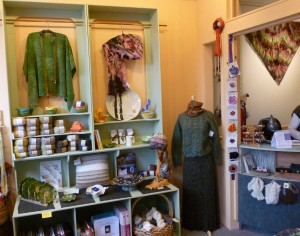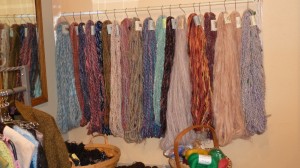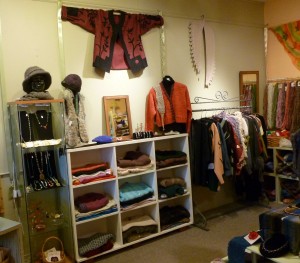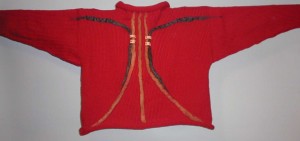
I own Black Mountain Artisans, (BMA) a little shop for fiber art in Point Reyes Station, about one hour north of San Francisco. The shop has existed nearly 25 years as a fiber artist’s cooperative. I took over 8 years ago. The store carries the work of some 45 different crafts professionals. BMA’s “mission” is to provide a brick and mortar outlet for local (Bay Area) artists and craftspeople who produce high quality art and art to wear. We prefer to carry original work that is made from locally sourced materials producing a minimal carbon footprint.
I am also a fiber and ceramics artist and have sold my work in other galleries and retail shops, through crafts fairs and now through Black Mountain Artisans.
Over my 40 plus creative years I have observed many artists and seen many sales approaches, seen different levels of competency and craftsmanship and witnessed a variety of artist’s attitudes towards their own work and towards retail stores. For most artists, marketing is a complex and often painful issue.
As a store owner and as an artist, I am very much aware of what the presenting artist goes through. When I have to tell an artist that I can’t carry his/her work, I try to be diplomatic and honest with the person as to why. It usually comes down to:
The work competes directly with work already in the store. As a store owner, I don’t want to jeopardize sales of another artist.
The quality is not good enough. As a store owner I need to protect the store’s reputation.
The artist is not local. This is specific to BMA, which prides itself on being an outlet for local artists.
The artist wants too much money and realistically it won’t sell for the price the artist wants. As a store owner ,I know my audience and I know that the store’s location is not suitable for very high price points. You may be able to sell your work for a lot more at other locations.
Having laid out some of the negatives up front, I would still encourage you to try to approach retail outlets to sell your work. Retailers need different works, so most owner/buyers will give you a chance to present your work. Your chances are 50/50 to get your work placed in the gallery or store.
Before you approach a retailer, there are certain things that you should take into consideration. It is important to know WHY you want to sell your work as well as HOW to sell it. Prepare a professional portfolio and know your price points, show dependability and mostly be enthusiastic about your work.
What is “marketing”?
Marketing is bringing your work to the attention of people, so they will see it, desire it, purchase it and use it.
Why do you want to market your work?
To my mind there are three types of fiber artists. Before you market your work you need to ask yourself why you want to sell your work. (1) do you just want to get some visibility for your work, or (2) do you need to make a living at your craft or (3) do you just want to make some extra money?
(1) If you just want to get some visibility for your work, you can donate your work at fundraisers, silent auctions. You could knit/crochet/weave for a charity or give your work to whom ever will wear it and thus advertise it for you.
(2) For artists that want to make a living from their work; you need to build up a portfolio, sell wholesale, retail, direct and online. Find ways of making things that sell and that you can make relatively fast and that can be repeated in different sizes. You will need to do production to build inventory. You need to be 100% dedicated to making, marketing and selling your work.
(3) Artists wanting to make extra money from the work they love to do. (which defines most artists at BMA). You have had positive feedback and you are now ready to sell some of your work. This way you are justified to buy new materials to do more of what you like to do and you are not stockpiling your work.
The marketing and selling of your work is principally the same in all these instances. Bringing your work to people’s attention is the same, so are the sales channels, the one difference is your NEED or DRIVE to sell.
Before you approach any store there are several things you need to be certain of:
Is your work “finished”? Edges should be straight if they are meant to be, loose ends worked in, pressed or otherwise finished. I look closely to the finishing details and how well it is constructed. From experience I know that other people like things that are not necessarily my taste and I do want to carry those items in my store, so I make sure that the piece has integrity and is of high quality and craftsmanship.
Is the store the right fit? Don’t sell your expensive hand woven scarf in a cheap import boutique. Most retail outlets have a “mission” or focus and your goods need to fit within their parameters. As the selling party you should be convinced that this is the right store for you. Does your work “fit” in the store? Would you be proud to have your work sold there? Do you want your name and work associated with that particular store?
Are you ready to part with your work? It has happened that artists who placed a garment in the store, have come back the next day to get their piece back because they could not part with it. This is a waste of the store owner’s time and if you change your mind in the future and want to sell other pieces, this store owner will hesitate to speak with you again.
Do you have an idea of what you want to get for the piece? You should have a price range in mind. Usually the shop owner can help you and will know what the right retail price is. The shop owner is motivated to sell the work sooner rather than later, and to get the most out of it. Work with the shop owner to establish the retail price. Negotiate a percentage rather than setting a firm wholesale price. You don’t want to sell your work for $50 to the shop and have him/her sell it for $200. Around 50% of retail to the artist is a normal percentage. After all of this, if you feel the shop owner can’t give you enough for the product, don’t sell it in a retail environment; go online or sell it at craft fairs.
How do you approach a retail store? Call and make an appointment to see the owner, ask when it is least busy in the store or the best time to come and show your work. Give the store buyer your web site, so he/she has an idea before seeing you. Don’t just walk in and say you have things you want to sell.
How do you prepare a presentation to the store buyer? Your presentation indicates your attitude towards your own work. If you plop a lose bundle on the counter and hold some piece up randomly, the impression you give is that you don’t really care for your work. So if you have scarves for example, wrap them individually, stack them neatly, have the shop buyer look at them individually. Point out the best features of the scarf, in other words, you need to “sell” your work.
What should you bring in to show? Bring your best work, but it has to be work that you want to sell. If you want to see whether the store would be interested in future or other projects you are doing, bring a sample, but indicate that it is a sample and that more in the same vane will be forthcoming.

How do you convince the store to carry your goods? Having said all of the above, the goods usually sell themselves. If you can’t convince the store owner to carry your goods, ask why and learn from it for the next store visit. Keep in mind that both, you the artist, and the store owner have the same goal in mind, and that is to sell your work as soon as possible for the highest price. If the store owner thinks your work won’t sell in the shop for what ever reason, then YOU don’t want to have your work there.
How do you convince the store to highlight your goods? This is almost as important as having the store carry your work. Ask the store owner whether a display window can be dedicated to your work for a period of time. Or see if you could have a rack for just your work. Or to have a mannequin display your wears. Or ask if you can do a trunk show of your work. If you suggest it and help organize the activities, usually the store owner will be delighted with this publicity.
When you have done all the right things and still the store owner won’t carry your work, ask him/her whether you can try another time? Leave the store on a positive note, leave a business card and photos, so you can always come back and the store buyer will remember you.